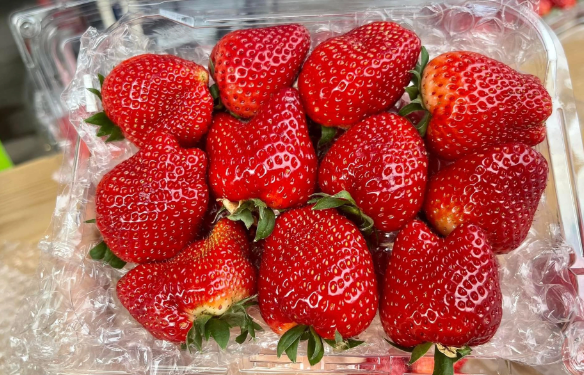The strawberry picking season in Son La Province’s picturesque landscape brings a flurry of activity and economic opportunities to local farmers. This year’s harvest was particularly promising, with prices ranging from 150 to 200 million Vietnamese dong per hectare, providing a steady income for farming enthusiasts. Harvest usually lasts from November to April, marking the culmination of months of careful cultivation and care.
In urban centers such as Hanoi, an influx of Sơn La strawberries is flooding markets, captivating consumers with a wide range of prices and package sizes. Strawberries are widely sold from roadside vendors to online stores, with prices ranging from 25,000 to 80,000 Vietnamese dong for a 500-gram box. A variety of sizes and pricing strategies meet a variety of consumer preferences, with smaller varieties often favored for their more intense flavor.
The success story extends beyond busy markets as farmers like Mr Minh Tien embrace the power of both offline and online sales channels. Offering insight into consumer behavior, Mr. Tien highlights the popularity of smaller-sized strawberries, prized for their rich flavor profile. Meanwhile, savvy consumers like Ms Nguyet Minh from Ku Gii district are buying in bulk, using the nutritional value of strawberries to make homemade dishes such as syrups.
Delving into the heart of production, Hoang Tuyet, a strawberry wholesaler from Muc Chau, sheds light on price dynamics and distribution channels. With strawberry prices ranging from 40,000 to 100,000 Vietnamese dong per kilo, wholesalers play a key role in connecting rural abundance with urban demand. Notably, cooperatives such as Xuân Quế contribute significantly to the provincial economy as a diverse range of strawberries are supplied to both the domestic and international markets.
Speaking about the current season, Mr. Nguyen Van Nam, Director of Xuân Quế Cooperative, expresses optimism amid the challenges, emphasizing the importance of sustainable growth and quality assurance. Having harvested and sold over 1,000 tons of strawberries, the cooperative remains committed to maintaining quality standards and expanding market reach.
As Son La diversifies agriculture, initiatives such as agritourism have emerged, offering visitors an immersive experience among the strawberry fields. These businesses not only increase economic returns, but also create greater awareness of the value of local products.
However, amid the prosperity comes concerns about quality control and branding. Without strict supervision and brand development, San La’s strawberry industry risks falling victim to fluctuating market demand and counterfeit products. Building consumer trust and creating a distinctive brand is essential to ensuring the long-term viability of the industry.












